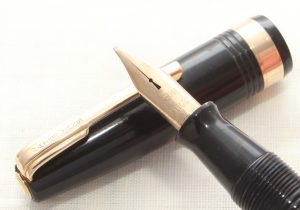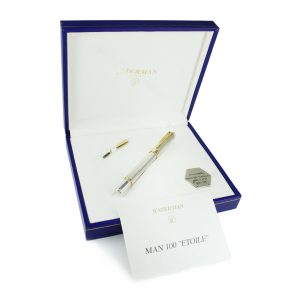In the first of a series about Fountain Pens, we’re going to be doing exactly what Worldcon did and travel around the world, taking a look at each country that’s held a Worldcon to see what sort of pens they use and what makes them special.
We’re starting in New York, America, where Worldcon did, and that brings us to the Waterman Pen Company. Founded in 1884 by Lewis Waterman, supposedly after a malfunctioning pen ruined a major contract for him by leaking all over it, and while the event was never proven, the results of his inspiration continue to this day. He was granted the patent for a “three fissure feed” in 1884 which became the first pen to include a mechanism that prevented ink from overflowing the pen when in use. As anyone who’s ever used a fountain pen before will testify, colourful fingers are a normal state of affairs, but the greatest frustration is when the pen decides that your fingers need the ink more than the paper does. Amidst fierce competition from other American companies such as Parker and Cross (which we’ll come to later in the series), the Waterman Pen Company became synonymous with quality and efficiency and became one of the leading producers of pens at the beginning of the new millennium, with sales attributed at more than a thousand a day by 1901.
Antique Waterman pens can still be found with relative ease, and given that many of them are more than a hundred years old, it’s a testament to the materials and workmanship that went into creating them. Here are images of a Waterman 16, made in 1901 and still writing to a level that could be used in everyday writing.







Waterman continued to innovate after the death of Lewis Waterman, being the first company to develop and install a clip to their pens and then to introduce the forerunner to the piston filling system, the lever supply system, allowing people to refill their pens without having to dismantle them. In 1939, they introduced the concept of a hundred-year pen, that would never fail, examples of which are still around today, as you’d expect, being a hundred-year pen.
Waterman had designs that they believed stood the test of time, and it was in choosing to remain with the same designs that led to their decline in the US, leading to them being taken up by their French subsidiary, JIF-Waterman.


Today, Waterman are still synonymous with quality, but their design range has flourished from the few models that were available when they first started out, and they have made sure that their pens are available to everyone, rather than concentrating solely on the higher end pens like some brands chose to. It’s possible to own a Waterman pen for the cost of a coffee and a pastry, as seen by the Waterman Allure.


But if you’re looking for the higher end of what Waterman have come up with, take a look at the Waterman Man 100 Etoile, retailing now for around the same as a new luxury car. While not all fountain pen manufacturers have made the leap across the years, Waterman continues to innovate whilst maintaining its reputation for reliability.


John C Dodd works conventions, that’s what he does, that’s all he does…
Co-Area Head for Mimo for Worldcon 2019, Committee at Eastercons since 2020, Director of Dragonmeet, Front of House at UK Games Expo, RPG manager at Airecon and UK Games Expo, Director of Longcon.
He’s a Swordsman, a Devotee of the Iron Church, a preacher of handwriting, and a writer of games, publishing his own RPG, Quest, in 2018. He’s been line developer of SLA Industries and has written for several different games companies, including Cubicle 7 and Modiphius Entertainment.
Find him at https://facebook.com/john.dodd.9022/, @automaticdodd on twitter, or by typing in Millionwordman into any search engine in the world
We are the Bid Team for Glasgow in 2024 – A Worldcon for Our Futures. We are part of the vibrant Worldcon community. We would love to welcome you to Glasgow and the Armadillo Auditorium for the 2024 Hugo Awards. Please consider supporting us.

